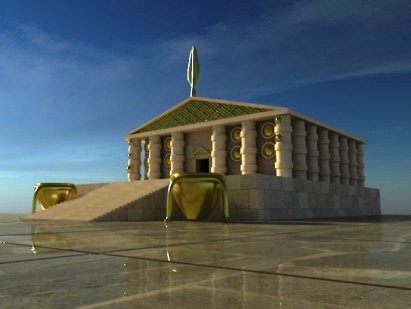|
·∏™aldi
·∏™aldi (dingir, d,''·∏™aldi'', also known as Khaldi) was one of the three chief deities of Urartu (Urarat/Ararat Kingdom) along with Teisheba and Shivini. He was a warrior god to whom the kings of Urartu would pray for victories in battle. ·∏™aldi was portrayed as a man with or without wings, standing on a lion. His principle shrine was at Ardini (Mu·π£a·π£ir). The temples dedicated to Khaldi were adorned with weapons such as swords, spears, bows and arrows, and shields hung from the walls and were sometimes known as "the house of weapons". History According to Urartologist Paul Zimansky, Haldi was not a native Urartian god but apparently an obscure Akkadian Empire, Akkadian deity (which explains the location of the main temple of worship for Haldi in Musasir, believed to be near modern Rawandiz, Rawandiz, Iraq). Haldi was not initially worshipped by Urartians, at least as their chief god, as his cult does not appear to have been introduced until the reign of Ishpuini of Ura ... [...More Info...] [...Related Items...] OR: [Wikipedia] [Google] [Baidu] |
Urartu
Urartu was an Iron Age kingdom centered around the Armenian highlands between Lake Van, Lake Urmia, and Lake Sevan. The territory of the ancient kingdom of Urartu extended over the modern frontiers of Turkey, Iran, Iraq, and Armenia.Kleiss, Wolfram (2008). "URARTU IN IRAN". ''Encyclopædia Iranica''. Its kings left behind cuneiform inscriptions in the Urartian language, a member of the Hurro-Urartian languages, Hurro-Urartian language family. Urartu extended from the Euphrates in the west to the region west of Ardabil in Iran, and from Lake Çıldır near Ardahan in Turkey to the region of Rawandiz in Iraqi Kurdistan. The kingdom emerged in the mid-9th century BC and dominated the Armenian Highlands in the 8th and 7th centuries BC. Urartu frequently warred with Neo-Assyrian Empire, Assyria and became, for a time, the most powerful state in the Near East. Weakened by constant conflict, it was eventually conquered, either by the Iranian peoples, Iranian Medes in the early 6th c ... [...More Info...] [...Related Items...] OR: [Wikipedia] [Google] [Baidu] |
Armenian Mythology
Armenian mythology originated in ancient Proto-Indo-European religion, Indo-European traditions, specifically Proto-Armenian, and gradually incorporated Hurrian religion, Hurro-Urartian religion, Urartian, Ancient Mesopotamian religion, Mesopotamian, Zoroastrianism, Iranian, and Greek mythology, Greek beliefs and deities."Armenia (Vannic)" by Archibald Sayce, A.H. Sayce, p.793-4; "Armenia (Zoroastrian)", by M(ardiros). H. Ananikian, p.794-802; in Encyclopædia of Religion and Ethics, ed. James Hastingsvol. 1 1908 Formation of Armenian mythology The pantheon of Armenian gods, initially worshipped by proto-Armenian language, Proto-Armenians, inherited their essential elements from the religious beliefs and mythologies of the Proto-Indo-Europeans and peoples of the Armenian Highlands. Historians distinguish a significant body of Indo-European languages, Indo-European language words which were used in Armenian pagan rites. The oldest cults are believed to have worshipped a creato ... [...More Info...] [...Related Items...] OR: [Wikipedia] [Google] [Baidu] |
Ardini
Muṣaṣir (Assyrian cuneiform: and variants, including Mutsatsir, Akkadian for ''Exit of the Serpent/Snake''), in Urartian Ardini was an ancient city of Urartu, attested in Assyrian sources of the 9th and 8th centuries BC. It was acquired by the Urartian King Ishpuini ca. 800 BC (see the Kelashin Stele). The city's tutelary deity was dḪaldi. The city's location is not known with certainty, although there are a number of hypotheses, all in the general area of , in the Zagros south of Lake Urmia. François Thureau-Dangin tentatively located it at Mudjesir, 10 km west of Topzawa. Reza Heidari, an archaeologist of the "Cultural Heritage and Tourism Organization" of Iran's West Azarbaijan Province claims Rabat city near Sardasht, Iran as the location of Muṣaṣir. H. F. B. Lynch claimed that it was close to the modern town of Rawandiz in Iraqi Kurdistan. Urartologist Paul Zimansky speculated that the Urartians (or at least the ruling family) may have emigrated ... [...More Info...] [...Related Items...] OR: [Wikipedia] [Google] [Baidu] |
Hayk
Hayk (, ), also known as Hayk Nahapet (, , ), is the legendary patriarch and founder of the Armenian nation. His story is told in the ''History of Armenia'' attributed to the Armenian historian Movses Khorenatsi and in the ''Primary History'' traditionally attributed to Sebeos. Fragments of the legend of Hayk are also preserved in the works of other authors, as well as in Armenian folk tradition. Etymology The name of the patriarch, ''Hayk'' (), is not exactly homophonous with the Armenian name for "Armenia," ''Hayk ª'' (). In Classical Armenian, ''Hayk ª'' is the nominative plural of ''hay'' ( ’∞’°’µ), the Armenian word for "Armenian." While Robert W. Thomson considers the etymology of ''Hayk ª'' (’Ä’°’µ÷Ñ) from ''Hayk'' (’Ä’°’µ’Ø) to be impossible, other scholars consider the connection between the two to be obvious and derive ''Hayk'' from ''hay''/''Hayk ª'' via the suffix ''-ik''. Martirosyan, Hrach (2010). ''Etymological Dictionary of the Armenian Inherited Lexicon'' ... [...More Info...] [...Related Items...] OR: [Wikipedia] [Google] [Baidu] |
Urartian Mythology
Urartian religion is a belief system adopted in the ancient state of Urartu, which existed from the 8th to 6th centuries BC. It was typical of Despotism, despotic states from the Near East. The Urartian religion was Polytheism, polytheistic in nature and derived from the earlier beliefs of Mesopotamia and Anatolia. As in other beliefs of the ancient Near East, Urartu had a , patronizing various phenomena. The main deity was ·∏™aldi, Haldi. The worlds of humans and gods were united through ritual sacrifices. The Urartian religion absorbed the motifs of the tree of life, the serpent and the winged solar disk characteristic of the ancient Near East. Against the background of Ancient Mesopotamian religion, Mesopotamian beliefs, Urartu was distinguished by a high level of religious tolerance, which was conditioned by the multinationality of the state. Sources for the study of Urartian religion Sources for the study of the Urartian religion are scarce. Scholars have a limited numbe ... [...More Info...] [...Related Items...] OR: [Wikipedia] [Google] [Baidu] |




